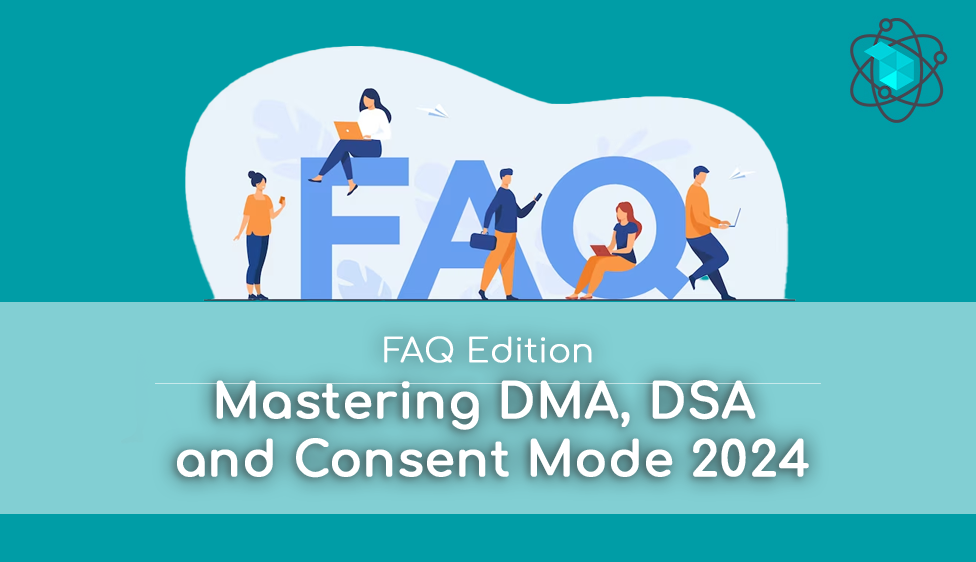Embarking on a transformative journey through the intricate landscape of digital regulations, we have not merely seen these regulatory changes as obstacles but as opportunities to showcase our expertise, provide immense value to our clients, and unlock new avenues for growth. Recognising the pivotal role of Consent Mode in the evolving digital advertising landscape, we proactively embraced these changes.
In our ongoing pursuit of knowledge sharing, we present a unique FAQ Edition blog post, delving comprehensively into the Digital Markets Act (DMA), Digital Services Act (DSA), and Google Consent Mode V2. Taking a step back, as we journeyed through this regulatory terrain, our commitment to demystifying complexities has been evident in each piece we crafted.
- We explored the significance of Consent Mode V2, shedding light on its features and illustrating why it’s crucial in the evolving digital advertising landscape
- We provided practical insights into implementing Consent Mode V2, offering a comprehensive guide on compliance and strategies to leverage its features for advertising success
- We delved into the DMA’s profound impact on tech giants, gatekeepers, and the challenges posed by compliance
- We took a deep dive into the regulatory landscape, navigating the challenges introduced by the DSA, thus providing businesses with a strategic guide for successfully navigating compliance
Disclaimer: as we present this FAQ Edition, your questions become the focal point of our continued knowledge sharing. So keep the inquiries coming, as this FAQ edition thrives on your questions! Reach out, and with your permission, we may feature your queries in upcoming blog posts.
Digital Markets Act: Navigating Compliance and Beyond
How do we ensure DMA compliance for our banner advertisements?
A: Achieving DMA compliance for banners requires meticulous practices. Dive into our comprehensive guide, exploring the intricacies of compliant banners, and understand how to align your digital marketing assets with DMA principles.
However, we understand that navigating regulatory nuances can be intricate. For personalised technical support and to ensure every aspect is in place, get in touch with us now. Our expert team is here to guide you through the process seamlessly. Let’s make sure your banner advertisements not only catch the eye but also comply with the evolving regulatory landscape 😉
Does the impact of DMA extend globally, or is it confined to the EU?
A: While the DMA originates from the European Union, its impact extends far beyond the borders of the EU. The regulation has global implications, particularly for companies operating on a global scale. Even if your business is based outside the EU, if it meets the specified criteria, it may fall under the purview of the DMA. Understanding the global reach of the DMA is crucial for businesses seeking comprehensive compliance and navigating the evolving landscape of digital regulations.
Why is DMA pivotal for marketers, and how does it reshape advertising strategies?
A: The Digital Markets Act implies for marketers a paradigm shift in advertising strategies. The DMA compels a reevaluation of how user data is managed, emphasising transparency and user consent. It challenges the status quo, moving away from unchecked dominance towards an ecosystem that prioritises fair competition and accessibility for businesses of all sizes.
Marketers need to adapt to these changes by refining their advertising strategies to align with the principles of the DMA. This involves a more transparent approach to data management, ensuring user consent is prioritised, and embracing a landscape where fair competition is at the forefront.
Are specific industries more affected by DMA, and how do these nuances manifest?
A: The impact of the Digital Markets Act nuances manifest differently in each industry, requiring businesses to conduct industry-specific assessments and tailor their strategies to comply with the regulatory framework. Our industry-specific breakdowns provide valuable insights to navigate these nuances effectively, send us a message to get yours!
Can DMA compliance be approached proactively to gain a competitive advantage?
A: Absolutely. Beyond mere adherence, proactive DMA compliance is an opportunity. By embracing it strategically, businesses can enhance brand reputation, build trust, and differentiate themselves in the competitive digital landscape. It’s not just compliance; it’s a path to leadership.
How can smaller businesses navigate DMA compliance with limited resources?
A: Navigating DMA compliance for smaller businesses requires a tailored approach. Focus on essential steps, such as prioritising key compliance areas, leveraging automation tools, and seeking industry collaborations. By strategically allocating resources and staying informed, smaller enterprises can efficiently navigate the regulatory landscape introduced by DMA.
In the event of non-compliance, what potential consequences might businesses face under DMA?
A: In the event of non-compliance, businesses may face severe consequences under DMA. Penalties can include substantial fines, restrictions on operations, and damage to brand reputation. To mitigate risks, proactive steps are crucial, such as regular compliance audits, staying updated on regulatory changes, and seeking legal counsel when needed. By prioritising compliance, businesses can navigate DMA regulations effectively and avoid potential repercussions.
Digital Services Act: Navigating Obligations and Preparing for Change
What types of organisations fall under the jurisdiction of the Digital Services Act?
A: Under the Digital Services Act, a broad range of organisations falls under its jurisdiction. This encompasses online platforms, hosting services, and various digital service providers. The DSA aims to regulate entities that play a significant role in the digital landscape, ensuring a safer, fairer, and more accountable digital environment.
When is the Digital Services Act set to come into effect, and how can businesses prepare in advance?
A: Great news – the Digital Services Act is already in full swing, effective as of 17 February 2024. While you can’t go back in time to prepare in advance, don’t worry! There’s still ample room to tackle DSA compliance. The key is to act now, so reach out to us, and let’s navigate the DSA landscape together 😉
How does DSA complement or differ from existing data protection regulations like GDPR?
A: The European Commission emphasises that the Digital Services Act complements the GDPR by introducing explicit restrictions on targeted advertising and dark patterns. It’s essential to note that the DSA does not modify the existing rules on data protection laid out in the GDPR or ePrivacy Directive.
What potential fines might businesses face under the Digital Services Act, and how can risks be mitigated?
A: Businesses under the Digital Services Act may face fines for non-compliance. The potential fines vary based on the severity and recurrence of the violation. To mitigate these risks, it’s crucial for businesses to proactively adhere to the DSA regulations, ensuring robust compliance measures and minimising the likelihood of facing financial penalties.
How can businesses maintain ethical advertising practices under DSA guidelines?
A: Maintaining ethical advertising practices under the Digital Services Act involves aligning with the guidelines set forth by the legislation. Businesses can uphold ethical standards by avoiding targeted advertising based on sensitive categories, ensuring transparency in algorithms, and prioritising user privacy. By adhering to DSA provisions, companies contribute to a more ethical digital advertising landscape.
What role do industry associations play in shaping DSA compliance, and how can businesses engage with them?
A: Industry associations play a pivotal role in shaping Digital Services Act compliance by fostering collaboration and sharing insights within sectors. Businesses can actively engage with these associations to stay informed about evolving interpretations of the DSA and contribute to a collective understanding of compliance challenges. Collaborative efforts within industry forums provide valuable platforms for businesses to navigate the complexities of the DSA and ensure a unified response to regulatory changes.
In the dynamic landscape of digital regulations, how can businesses stay adaptable to future amendments introduced in the DSA?
A: Adaptability is essential. In the dynamic landscape of digital regulations, businesses can stay adaptable to future amendments introduced in the Digital Services Act by adopting proactive approaches. It involves staying ahead of the curve, anticipating potential changes, and continuously monitoring updates to ensure compliance. This adaptability allows businesses to navigate the evolving regulatory landscape with agility, positioning themselves to meet new requirements and emerging challenges effectively.
Consent Mode V2: Optimising Google’s Latest Updates
Beyond the basics, what are the advanced features of Google Consent Mode V2?
A: Beyond the basics, which you can still access here, our recent webinar delves into the advanced features of Google Consent Mode V2. Advertisers can relive the experience and gain detailed insights by watching the webinar recording via this link. The breakdown explores these advanced features, providing advertisers with the knowledge to harness the full potential of Google Consent Mode V2 for enhanced campaign performance.
How does Consent Mode V2 integrate with existing marketing technology stacks, and what considerations should businesses keep in mind during integration?
A: Integrating Consent Mode V2 into your existing marketing technology stack requires careful consideration. Start by assessing compatibility and exploring available APIs and documentation from Google. Clearly define how consent data will be mapped and shared across your stack, and communicate these changes transparently to users. Thorough testing is crucial before deployment to identify and address potential issues. Ensure legal compliance throughout the integration process!
By the way, if you’re using a specific marketing tech platform, we may already have collaboration experience and can guide you through the integration process. Feel free to reach out, and we can be your guiding angel through this integration journey.
Can Consent Mode V2 be used as a standalone solution for user consent, or is a cookie banner still necessary?
A: Consent Mode V2 serves as a robust solution for user consent, but its role in relation to cookie banners is nuanced. While it addresses certain consent aspects, a comprehensive approach may still involve a cookie banner, especially for capturing preferences beyond the scope of Google services. The interplay between Consent Mode V2 and cookie banners depends on your specific needs and the extent of user data processing on your platform.
What potential consequences might businesses face for not implementing Google Consent Mode V2, and how can these risks be mitigated?
A: Non-implementation of Google Consent Mode V2 may expose businesses to various risks, including potential disruptions to personalised advertising and the loss of valuable user insights. The ramifications could extend to non-compliance with privacy regulations, impacting brand reputation and inviting legal consequences. To mitigate these risks, businesses should proactively adopt Consent Mode V2, ensuring compliance with evolving privacy standards.
How can businesses ensure transparent communication with users regarding the implementation of Google Consent Mode V2?
A: Transparent communication with users is paramount when implementing Google Consent Mode V2. Businesses should craft clear and concise messages that inform users about the purpose and benefits of Consent Mode V2. This communication should highlight the protection of user privacy, the personalisation of ad experiences, and the overall enhancement of their online interactions. By adopting a user-centric approach and being transparent about data practices, businesses can build trust and foster a positive relationship with their audience.
Empowering Your Digital Journey Continues
As we conclude this in-depth FAQ Edition, our commitment to clarity and innovation amplifies. Your questions are the driving force behind our pursuit of knowledge. This FAQ is a living document! Keep your inquiries coming, and stay tuned for ongoing insights.

